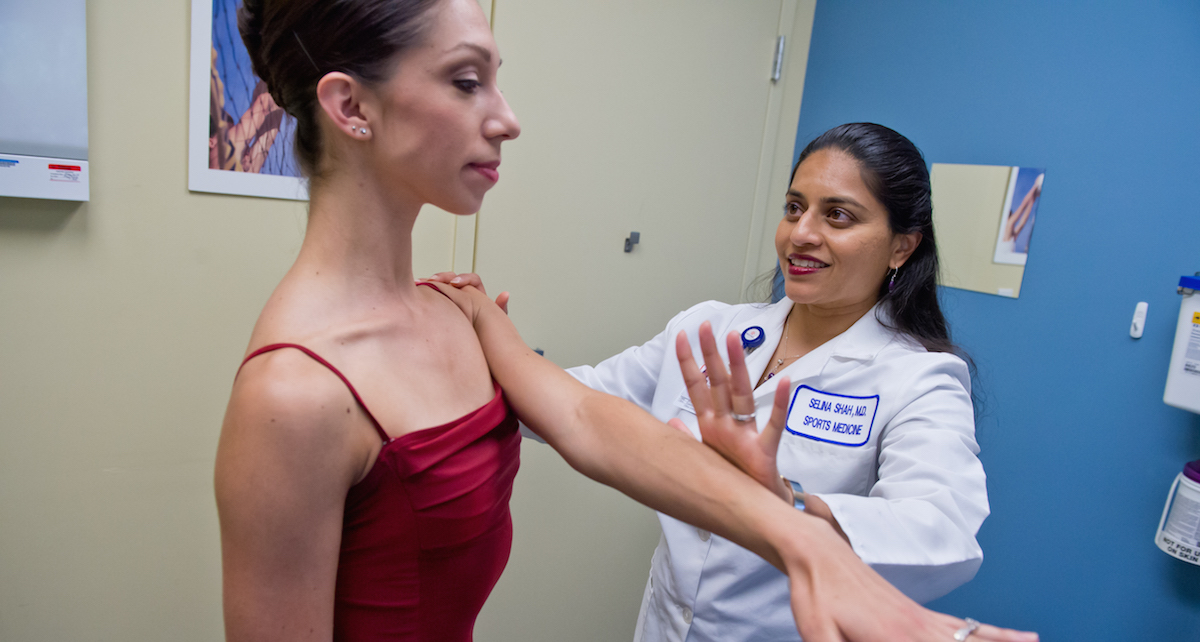The next in Dance Informa’s “5 Things I Want to Tell Dancers” series. Here, we receive advice from a dance-medicine specialist about staying injury-free and at the top of your game. Check back in the months ahead for guidance from other experts!
Dr. Selina Shah knows dance from the inside out — as a dancer trained in ballet and other forms and as director of dance medicine at the Center for Sports Medicine, in San Francisco and Walnut Creek, California. In addition to serving as team doctor for USA Figure Skating, USA Synchronized Swimming and other Olympic teams, Dr. Shah is the physician for dance companies, theatre groups and colleges in the Bay Area.
Dr. Shah is a researcher as well. She has published original studies on injuries in contemporary dancers and is a member of DanceUSA’s Task Force on Dancer Health and an officer of the International Association for Dance Medicine and Science.
Here are her strategies for working at your best for a long time.

Dr. Selina Shah, director of dance medicine at the Center for Sports Medicine, in San Francisco and Walnut Creek, California. Photo courtesy of Dr. Shah.
#1. Listen to your body.
Vastly different injuries arise from a common cause, says Dr. Shah, explaining, “You want to look fantastic and take shortcuts to achieve this.” For instance, she points out, no matter how many times dancers are warned against this, they may fake a bigger turnout by rolling the ankles forward, turning out from the knees and swaying the lower back. For a high extension, many overuse the flexors in the front of the hip, such as the iliopsoas and quadriceps, or “quads”.
Shortcuts are, in fact, shortsighted. They cause aches and pains and can eventually produce serious injuries, even if you think you’re not doing them very much or very often. Pay attention to the discomfort messages, says Dr. Shah. “They’re your body’s signals that you must work within your limits as you figure out how to improve range of motion and other attributes,” she explains. It may take a little longer to achieve the aesthetic you want, but your technique will develop properly, and you’ll avoid hurting yourself.
#2. Translation, please!
Teachers may give corrections that seem poetic or mysterious but are, in fact, important, according to Dr. Shah. “Feel the floor” is an example, she says. She decodes this phrase as, “Have the pressure points of the feet fully in contact with the floor, with a sensation of weight throughout the foot.” Doing this is critical because you’ll strengthen the muscles of your feet and prepare them for more advanced training, including pointe work, she explains.
If you don’t understand a correction, stay after class to ask for an explanation, suggests Dr. Shah. Or arrange a private lesson. “In a class packed with students, a teacher may not be able to give everyone individual attention,” she adds.
#3. Think outside the box.
Many dance groups, including ballet companies, have widely varied repertories these days. Dr. Shah feels that company class should include material that prepares the dancers for this. “Ballet is a great foundation for much of Western dance, and it serves many dancers well,” she says. “However, they may need additional skills for new repertory.”
Meanwhile, freelance dancers may get calls from numerous choreographers representing a spectrum of styles. “Cross-train with several ballet and modern styles,” Dr. Shah suggests to these independent performing artists. “Develop gymnastics or other skills you think might be required of you. That way, you’ll be ready for whatever comes along.”
#4. Widen your horizons.
For some, seeking varied perspectives requires extra effort. “You may live in an area with few choices for teachers and other practitioners,” says Dr. Shah. “My Bay Area practice has patients who come from 300 miles away.”
If your hometown has minimal dance resources, she suggests benefitting from travel to new places. If possible, take class there or make an appointment with a doctor or other provider.
#5. Take care of yourself — now.
Many dancers are focused so intently on their careers that they are willing to keep going, despite serious injury. Worse, they are often admired for it, encouraging other dancers to do the same.
Pushing yourself beyond reasonable limits can cause bad — or permanent — damage, according to Dr. Shah. “You have to look at the big picture,” she says. “Address an injury sooner rather than later by seeing a physician who understands body mechanics or, even better, specializes in dance.”
Dr. Shah says that understanding your limits while working to improve your dancing will minimize injuries and ensure you have a long and healthy career.
By Stephanie Woodard of Dance Informa.
Photo (top): Dr. Selina Shah at work. Photo courtesy of Dr. Shah.















